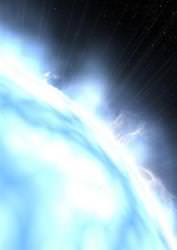When stars like our Sun run out of fuel, they die a long slow death as a white dwarf, slowing cooling down over billions of years. But now an international team of astronomers has found an unusual form of white dwarf with a bare carbon core; one that might suggest a new sequence of stellar evolution. A fate for stars right on the edge of detonating as supernovae.
The majority of stars that die eventually become white dwarfs in the end. The most massive 2-3% of stars will actually detonate as supernovae when they end their lives. But these newly discovered objects might have been right at the borderline. If they were just a little more massive, they would have detonated as well, but instead, they didn’t quite make it.
The evidence was gathered by astronomers from the University of Arizona, Université de Montréal and Paris Observatory. They reviewed more than 10,000 new white dwarfs found in the most recent update to the Sloan Digital Sky Survey. This automated survey has turned up four times as many white dwarf stars as previously known.
As stars run out of hydrogen, they switch to helium, and as this burns off, they’re left with a core of carbon and oxygen surrounded by an atmosphere of hydrogen or helium. That’s what a normal white dwarf looks like.
But a small group of these white dwarfs have a very bizarre appearance. They’re just a bare core of carbon, without any surrounding atmosphere of hydrogen or helium.
From the press release announcing the discovery, researcher Patrick Dufour describes the discovery, “when I first started modeling the atmospheres of these hotter DQ stars, my first thought was that these are helium-rich stars with traces of carbon, just like the cooler ones. But as I started analyzing the stars with the higher temperature model, I realized that even if I increased the carbon abundance, the model still didn’t agree with the SDSS data. Out of pure desperation, I decided to try modeling a pure-carbon atmosphere. It worked. I found that if I calculated a pure carbon atmosphere model, it reproduces the spectra exactly as observed. No one had calculated a pure carbon atmosphere model before. No one believed that it existed. We were surprised and excited.”
The researchers believe you need to have a star with 9-11 solar masses to create a carbon star like this. They’re planning follow up observations to better pinpoint the masses of the objects they’ve discovered so far.
Original Source: UA News Release


Every women’s dream a diamond star